It’s been a while since we’ve seen a tablet from Google (R.I.P. Pixel Slate). But it looks like the company is ready to get back into the fray as the Pixel Tablet has been officially announced at Google I/O 2023. The 11-inch slate is the first tablet to feature Google’s Tensor G2 chip and the certified Titan M2 security chip.
And while some tablets are trying their hardest to be so-called laptop replacements, the Pixel Tablet is staying in its lane and aiming for the entertainment and smart home spaces. To prove it, the Pixel Tablet is bringing out another first –– it’s the first tablet with Google Chromecast built in.
Google gave me the opportunity to go hands on with this nifty device, and while I’m still not the biggest tablet fan, I’m pretty sure I know what I’m getting my Mom for Christmas. Read on to learn more about Google’s return to the tablet arena.
Pixel Tablet pricing and configurations
Leak busted. While some rumors, priced the Pixel Tablet somewhere around $600, in actuality, the base model will cost $499 when it becomes available. For that sum, you’re getting a slate equipped with Google Tensor G2 with the Titan M2 security coprocessor, 8GB of RAM with 128GB of onboard storage.
Pixel Tablet design
Ugh, I hate the phrase, “feels good in the hand,” but when it comes to the aluminum rear panel that sports a nano-ceramic coating, it fits just as well as the tablet does in my hand. The coating gives the Pixel Tablet a feel that’s similar to porcelain. Speaking of Porcelain, that was the name of the bone white coloring the demo tablet had. The slate’s also available in Hazel and Rose, but be aware the hues are much more muted than their names suggest.
In an effort to be eco-conscious, the Pixel Tablet is made from 30% recycled materials with 100% of the aluminum being recycled.
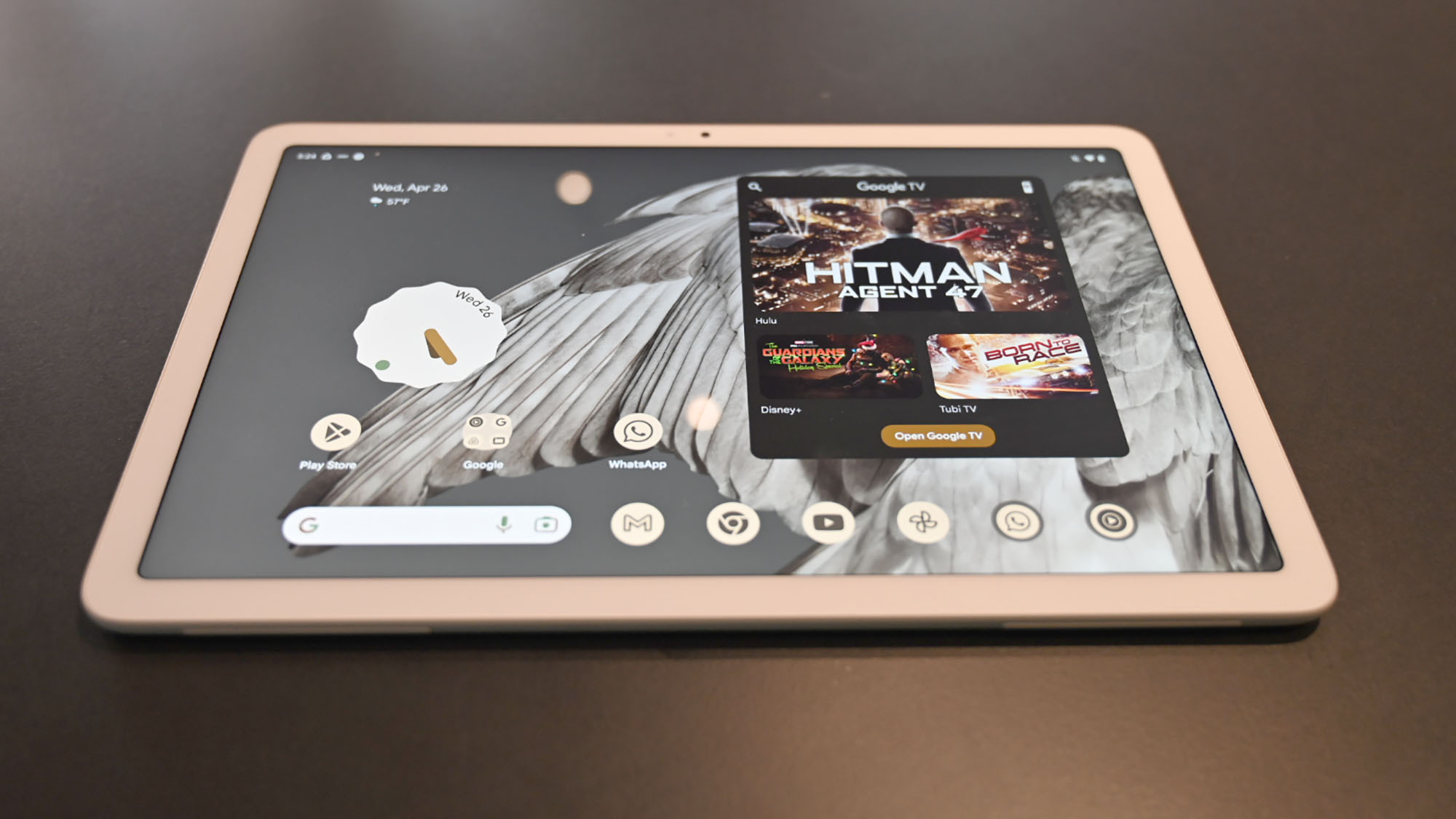
The 8-megapixel rear panel is located in the top-left corner. A glossy G sits towards the bottom of the panel just above the golden magnetic Pogo charging connectors. The glossy display that occupies the majority of the front of the tablet is encased in rather thick white bezels. They’re not thicker than anything you’d find on another tablet, but I hope that the day is coming when the bezels shrink in favor of more screen real estate. The 8MP front shooter sits center stage in the top landscape bezel.
A quick tour around the sides reveals the power button and volume buttons at the top and a USB Type-C port on the right. Vents for each of the four speakers sit along the sides.
Even though I’m not the biggest tablet fan, it’d be a shame if your pretty new tablet took a tumble and got damaged in the fracas. Never fear, Google has the Pixel Tablet Case to protect your tablet, complete with a shiny large ovular piece of metal that acts as an adjustable kickstand. And while the shape seems unwieldy, it’s the perfect shape to fit snugly around the speaker dock (more on that later).
Now for the dimensions, the Pixel Tablet weighs 17.4 ounces and measures 10.2 x 6.7 x 0.3 inches. Compare that to the Samsung Galaxy Tab S8 (10 x 6.5 x 0.25 inches) and iPad Air (9.7 x 7 x 0.24 inches), which weigh 1.1 pounds and 1 pound, respectively.
Pixel Tablet security
So let’s talk security as the Pixel Tablet has plenty. First, you have the fingerprint scanner baked into the power button. But then there’s the Titan M2 security chip making its first appearance in a tablet. A custom piece of silicon, the Titan M2 is a dedicated security chip with its own separate memory, RAM, and cryptographic accelerator. The last piece of this is part of the secret sauce when it comes to encryption. In short, it’s the smartphone’s version of a laptop’s TPM (Trusted Platform Module).
Software-wise, Pixel Tablet owners can expect a minimum five years security updates.
Pixel Tablet display
I’m not going to lie to you; I got distracted during my Pixel Tablet briefing. The Google rep was showing off his adorable daughter and the pictures were so clear, it was all I could do not to try to pinch her chubby rosy cheeks through the 11-inch, 2560 x 1600, 16:10 aspect ratio LCD display.
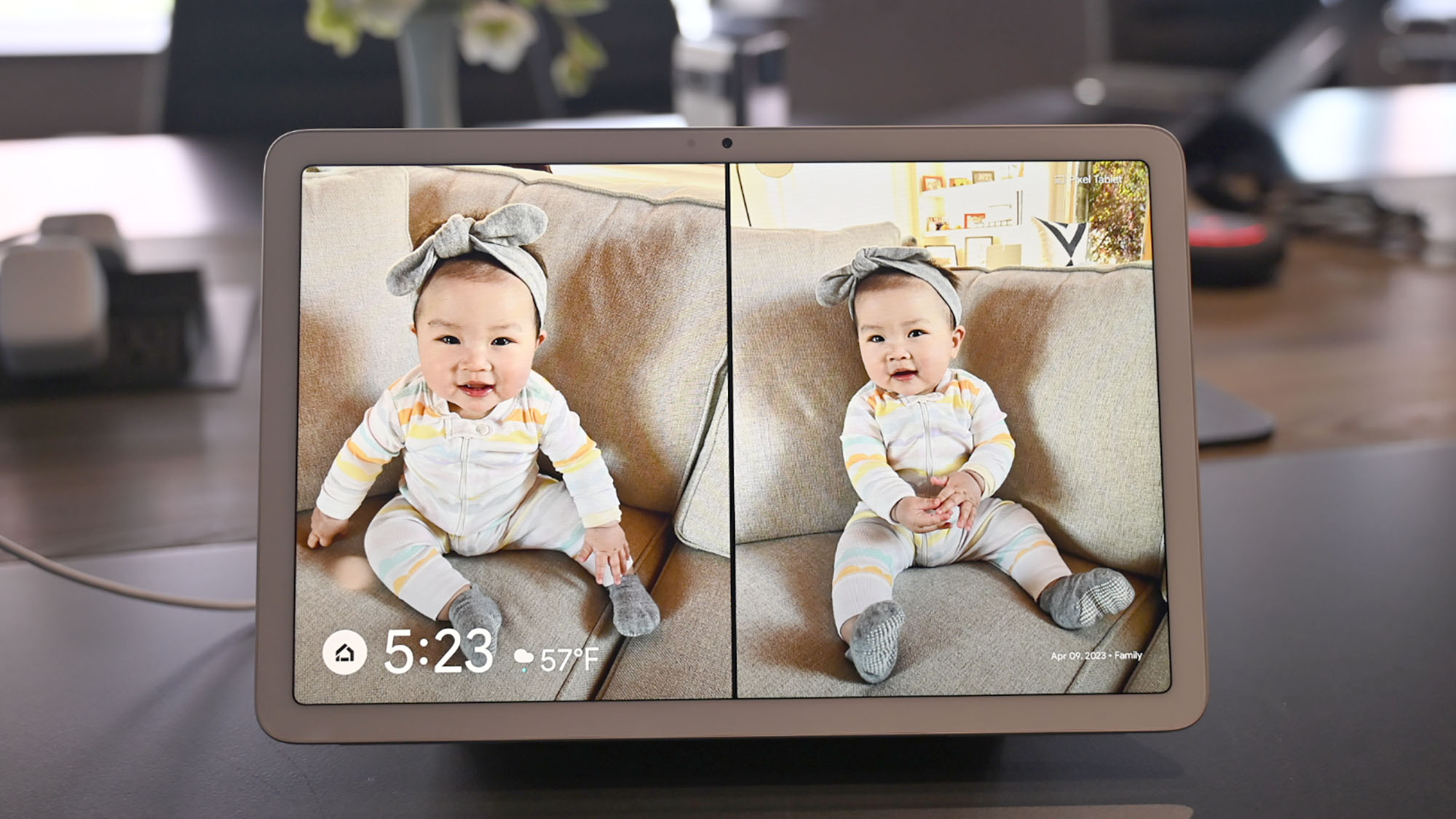
The touch display is packed with pixels to the tune of 276 ppi (Pixels Per Inch), matching the Galaxy Tab S8, and is slightly more than the iPad Air’s 264 ppi. Looking at the presenter’s pictures, I was impressed with how well it reproduced skin tone and how vivid colors looked overall. But as the king of vivid displays, I’m really excited to see how the Pixel Tablet will fare against its rivals.
To give you an idea of what the Pixel Tablet is up against, on the DCI-P3 color gamut, the S8 Tab reproduced 72% of the gamut in its Standard mode and a stunning 112% in Vivid mode. The iPad Air, on the other hand, hit 79%.
Google estimates an average 500 nits for the Pixel Tablet which is good enough to top the iPad Air’s 485 nits. However, the Tab S8 averaged a blinding 585 nits.
Pixel Tablet audio
The pair of speakers on either side of the tablet gave me a taste of their power during the demo and I’m definitely hungry for more. I chose Megan Thee Stallion’s “Her” to test out the slate’s ability to handle the low end and I wasn’t disappointed. The deep pulsing bass line was nice and full. Now was it loud enough to fill the large conference room the demo was held in? No, but it got much better when placed on the Charging Speaker Dock that comes bundled with the tablet.
Pixel Tablet Charging Speaker Dock
While it’s true that you can use the Pixel Tablet as — well — a tablet, it can also be the centerpiece of your smart home kingdom when connected to the Charging Speaker Dock. Once connected, the dock wears many hats, including a speaker, charger, and a smart home hub. It’s a cool feature that we’ve seen before from Lenovo with its SmartTab M10 Plus and a non-detatchable take on the idea with the Amazon Echo Show. Still, I’m of the opinion that Google has taken a more seamless and elegant approach.
Similar to the Google Nest and Nest Mini, the Charging Speaker Dock has a fabric covering. The dock is colored in a light gray that’s easy to blend into your existing home decor. But it’s not so bland that it couldn’t be a design centerpiece. Unfortunately, I don’t have dimensions for the dock, but it’s small enough to fit on a bookcase or small shelf.
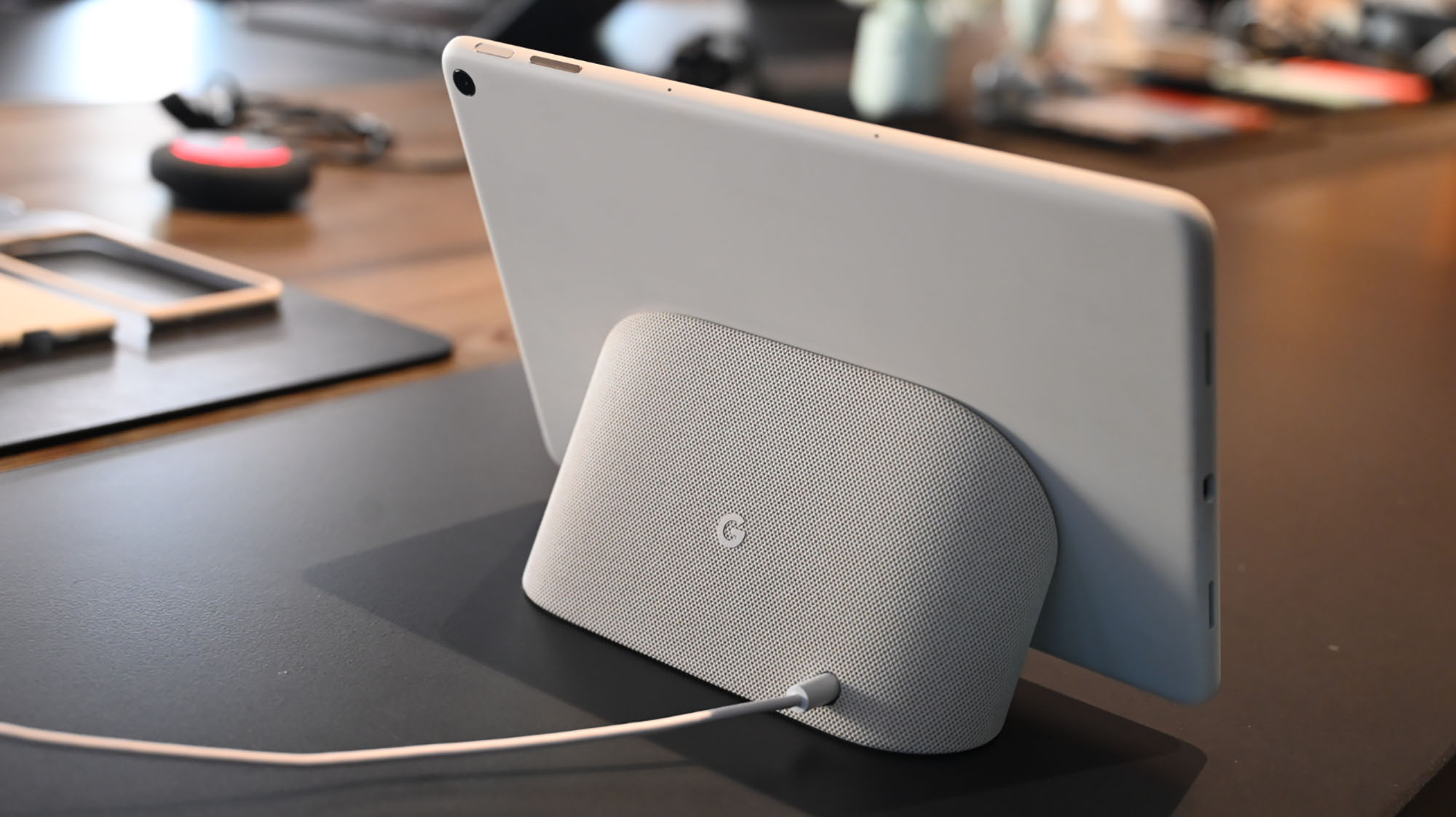
During my demo, I was happy to see that the connection between the Pixel Tablet and the Charging Speaker Dock is near instantaneous. No sooner was the tablet placed on the dock than it was transformed into a digital photo frame with more pictures of the presenter’s chubby-cheeked cherub. Unlocking the tablet, I was met with the Home screen where I saw icons to control several smart home devices including thermostats, smart lights and locks. You can even view security cameras. And since this is a Google production, the Google Assistant is baked into the experience with a simple utterance of “Hey Google.”
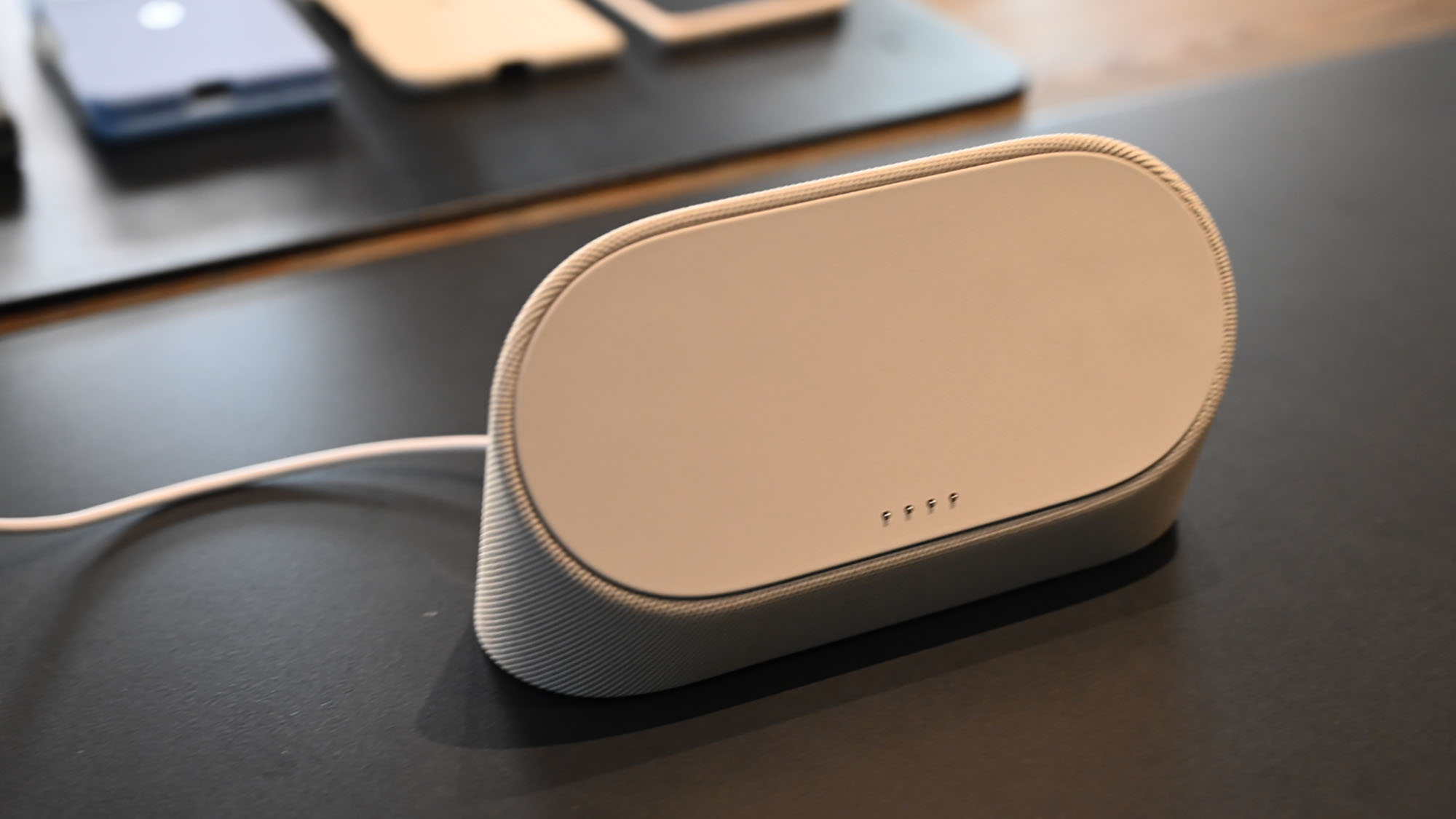
The Dock also greatly enhances the Tablet’s audio experience. I mentioned using “Her” as my test song during the demo. And while it sounded good on the Pixel Tablet, when connected to the Charging Speaker Dock, the audio performance improved exponentially. I got much better volume and the Dock’s full-range driver did really well with the bass, providing the meaty thump I was expecting. I’m really looking forward to myself or one of my staff putting this dock through its paces audio-wise.
With everything that the Dock does, it also charges the Pixel Tablet with a 15W max charging rate.
Pixel Tablet performance
I didn’t have much time with the Pixel Tablet, so I couldn’t run any of our benchmarks. But what I can say is that navigating through the tablet’s interface was a smooth, zippy experience. But that doesn’t mean that I can’t give you a taste of what to expect from the slate’s Tensor G2 chip. All we have to do is look at the Pixel 7 Pro and Pixel 7 smartphones, both of which are powered by the G2 chip.
On Geekbench 5, the Pixel 7 Pro notched 3,046 while the Pixel 7 hit 3,021. The Galaxy Tab S8’s Qualcomm Snapdragon 8 Gen 1 CPU reached 3,228 while the iPad Air and its Apple M1 8-core CPU blew everything else out of the water with 7,151.
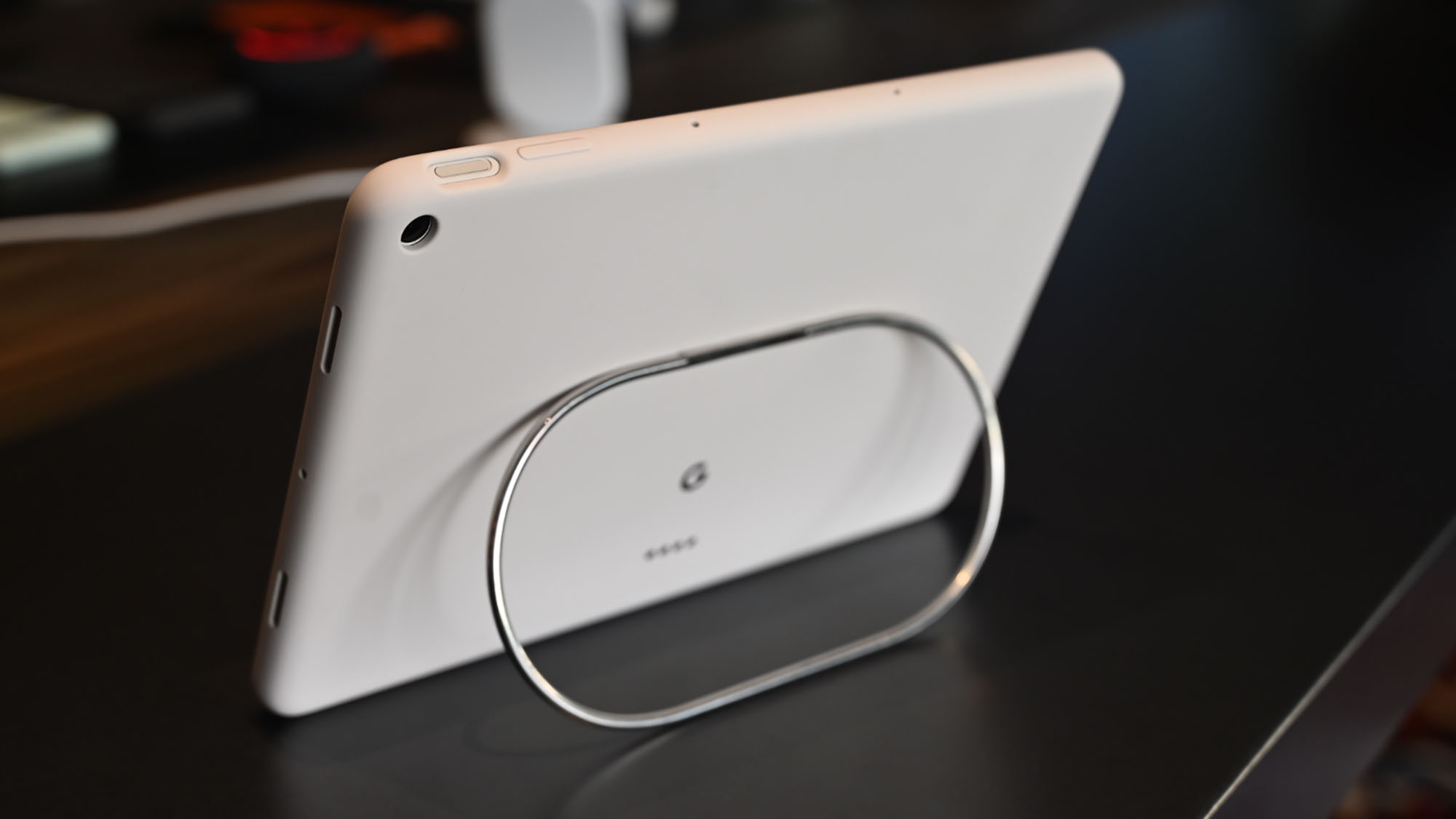
When we ran the Jetstream 2 benchmark (higher is better) the Pixel 7 Pro 12 posted 121.1 while the Pixel 7 got 151.1 and the Tab S8 reached 120.3. But once again, the iPad Air came out on top with 207.2.
During our Adobe Premiere Rush video transcoding test which requires the tablet to convert a 4K video to 1080p resolution. The Pixel 7 and 7 Pro finished the task in a dead heat with a time of 47 seconds. The Tab S8 wasn’t too far behind at 0:48. But that M1 chip is hard to beat with a blistering time of 0:22.
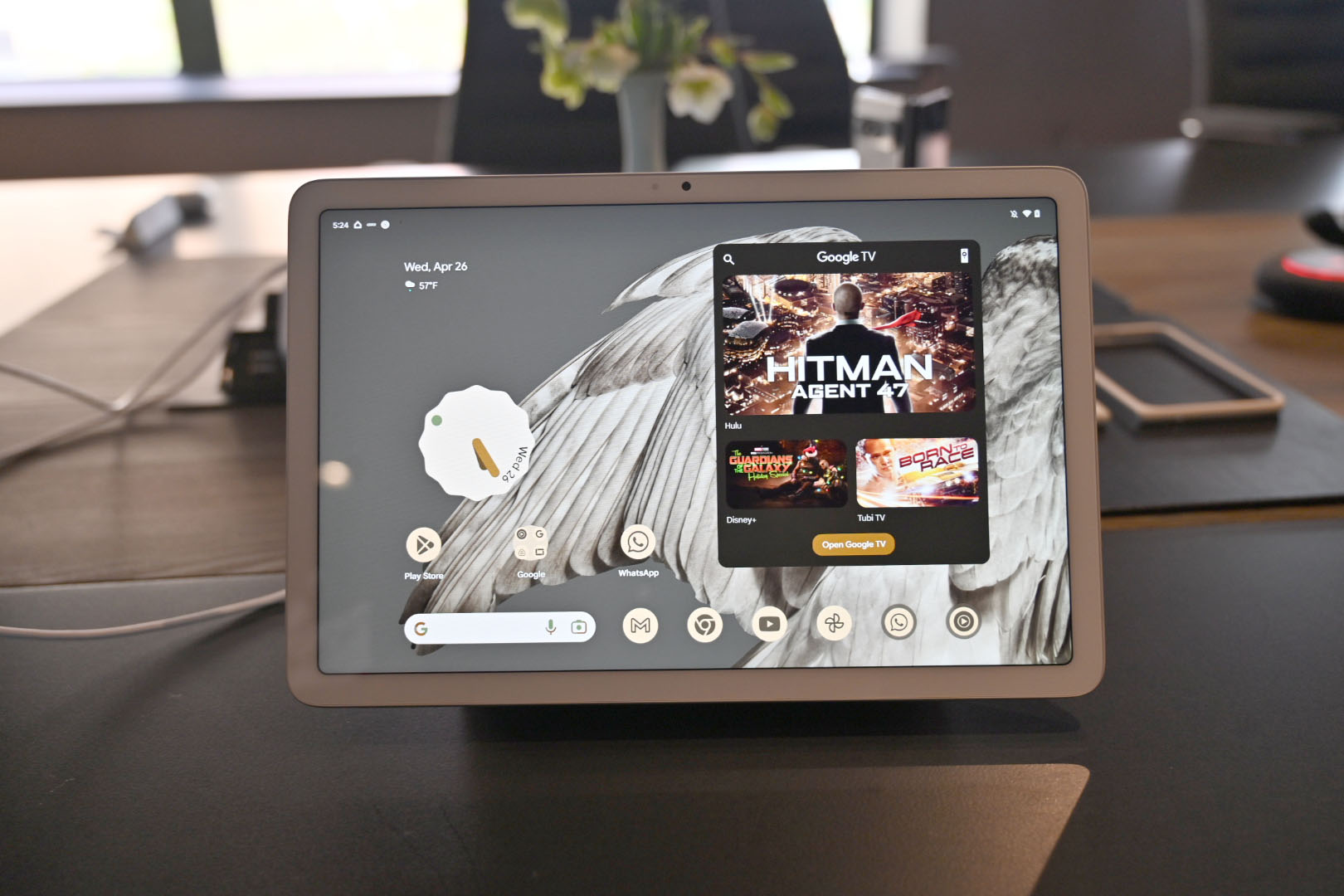
In order to test for graphics, we ran the Wild Life Unlimited benchmark and we saw the same pattern emerged. The Pixel 7 and 7 Pro hit 11 frames per second. The Tab S8 did a little better at 14 fps while the iPad Air posted 29 fps.
Pixel Tablet cameras
Both the front and the rear cameras on the Pixel Tablet are 8MP with a 1080p video recording at 30 fps. And as no one’s really using tablets as their main shooter (at least, I hope not), these cameras aren’t really anything to write home about. They can handle your video calls, or snapping a photo or two here and there.
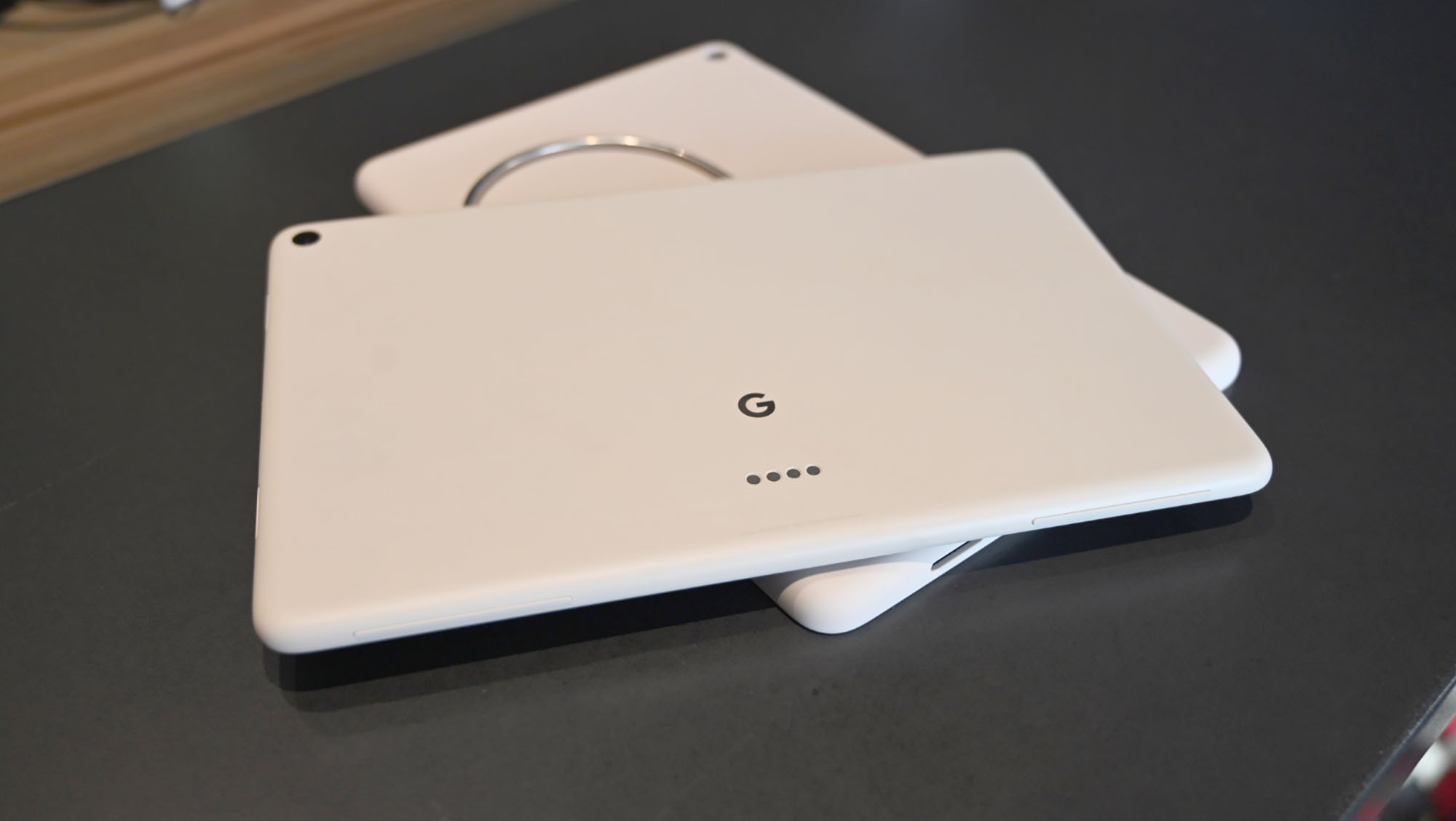
And if you need it for productivity, it’s good for scanning documents. In terms of specs, the f/2.0 aperture for the front and back cameras is the best thing it has going for it. Fixed focus, a 1/4″ sensor size, and the fact that they put the same sensor in the front and back all suggest Google doesn’t intend for you to use them for anything elaborate.
The cameras may not be the crème de la crème, but Google didn’t skimp on the accouterments, bringing popular features like Magic Eraser, Photo Unblur and Night Sight to the mix alongside a host of other photo settings.
Pixel Tablet battery life
Google says that the Pixel Tablet has an estimated battery life of up to 12 hours of video streaming. It’ll be interesting to see how it lasts on the Laptop Mag Battery test. The Galaxy Tab S8 gave us a time of 12:59 when the display is set to 60Hz and 12:51 on Adaptive mode. Meanwhile, we saw a rare stumble from the iPad Air with a time of 10:09.
Bottom line
When it comes to the Google Pixel Tablet, the company didn’t make a better mousetrap per se, but it is an intriguing one. Choosing to go the entertainment/smart home route takes some of the pressure off of the slate. Sure, it’s more than powerful enough to run games, stream videos and even do some light productivity work. But at the end of the day, it’s not trying to be a laptop replacement like some of its competitors on the market.
For the money, you get a stylish, well-built slate with all the Google goodness baked in that can effortlessly switch from a tablet to a smart home hub. Speaking of which, I definitely appreciate that the Charging Speaker Dock is included with the tablet so consumers can get the full experience out of the box. I’m excited to see how the Tensor G2 chip performs in tablet form, especially when it comes to battery life.
Stay tuned for our full review of the Pixel Tablet.
Source link
 notebook.co.id informasi dan review notebook laptop tablet dan pc
notebook.co.id informasi dan review notebook laptop tablet dan pc